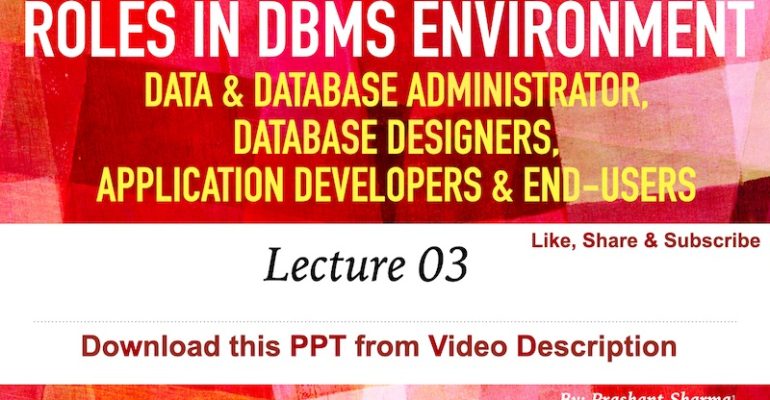Roles in DBMS Environment, DBA Role, Database Designers

Roles in DBMS Environment, DBA Role, Database Designers
Download Presentation
 Loading...
Loading...
There are four distinct types of people that participate in the DBMS environment: data and database administrators, database designers, application developers, and the end-users.
Data Administrators
The database and the DBMS are corporate resources that must be managed like any other resource. The Data Administrator (DA) is responsible for defining data elements, data names and their relationship with the database.They are also known as Data Analyst.
Database Administrators (DBA)
A Database Administrator (DBA) is an IT professional who works on creating, maintaining, querying, and tuning the database of the organization. They are also responsible for maintaining data security and integrity. A DBA has many responsibilities. A good performing database is in the hands of DBA.
DBA Responsibilities
The life cycle of database starts from designing, implementing to administration of it. A database for any kind of requirement needs to be designed perfectly so that it should work without any issues.
Once all the design is complete, it needs to be installed. Once this step is complete, users start using the database. The database grows as the data grows in the database. When the database becomes huge, its performance comes down.
Also accessing the data from the database becomes challenge. These administration and maintenance of database is taken care by database Administrator – DBA.
Installing and upgrading the DBMS Servers
DBA is responsible for installing a new DBMS server for the new projects. He is also responsible for upgrading these servers as there are new versions comes in the market or requirement.
Design and implementation
He should be able to decide proper memory management, file organizations, error handling, log maintenance etc for the database.
Performance Tuning
Since database is huge and it will have lots of tables, data, constraints and indices, there will be variations in the performance from time to time.
It is responsibility of the DBA to tune the database performance.
Backup & Recovery
Proper backup and recovery programs needs to be developed by DBA and has to be maintained him. This is one of the main responsibilities of DBA. Data should be backed up regularly so that if there is any crash, it should be recovered without much effort and data loss.
Documentation
DBA should basically maintain all his installation, backup, recovery, security methods. He should keep various reports about database performance.
Security
DBA is responsible for creating various database users and roles, and giving them different levels of access rights.
Database Designers
Logical Database Designers
The logical database designer is concerned with identifying the data (that is, the entities and attributes), the relationships between the data, and the constraints on the data that is to be stored in the database.
The logical database designer must have a thorough and complete understanding of the organization’s data and any constraints on this data.
Physical Database Designers
The physical database designer decides how the logical database design is to be physically realized.
- mapping the logical database design into a set of tables and integrity constraints.
- selecting specific storage structures and access methods for the data to achieve good
performance.
Application Developers
Once the database has been implemented, the application programs that provide the required functionality for the end-users must be implemented. This is the responsibility of the application developers.
They are the developers who interact with the database by means of DML queries. These DML queries are written in the application programs like C, C++, JAVA, Pascal etc.
End Users
The end-users are the ‘clients’ for the database, which has been designed and implemented, and is being maintained to serve their information needs.
Sophisticated Users
The sophisticated end-user is familiar with the structure of the database and the facilities offered by the DBMS.
Naive Users
These are the users who use the existing application to interact with the database. For example, online library system, ticket booking systems, ATMs etc




Comments (4)
Shilpa baghel
Easy and understandable language. I was enjoyed when am reading this.
Thank you 😊
admin
thanks 🙂
tasnim
thanks for your efforts, i understand a lot about it.
thanks again.
BILLY
its very clear and easily understandable, Thanks a lot.